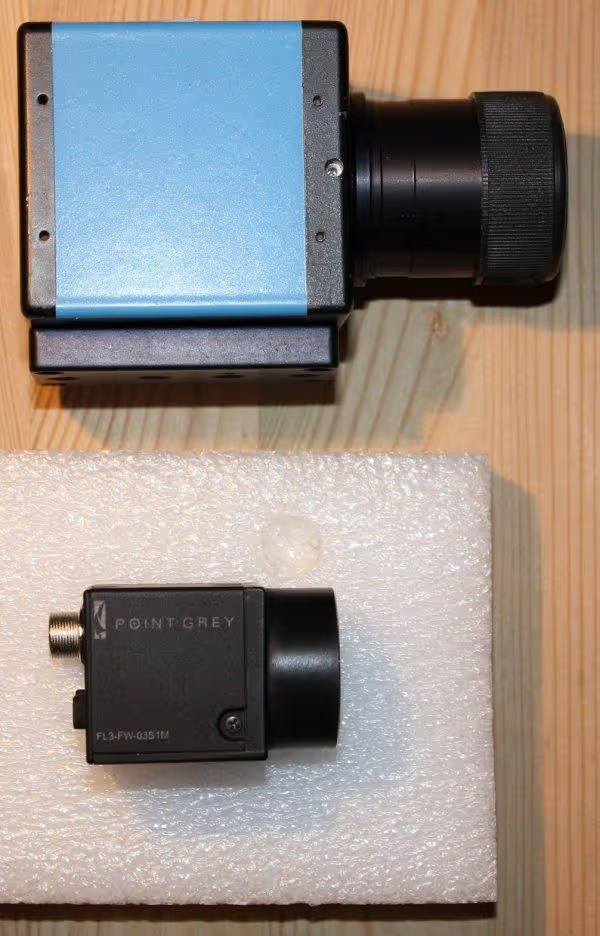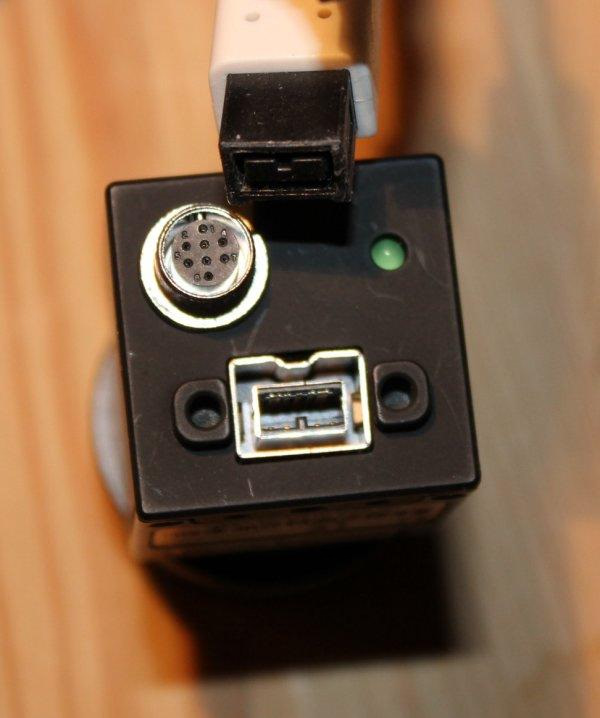Flea 3 with ICX618 CCD - the best thing for planetary imaging
Looking through top class planetary images you could notice that many of them were made with Flea 3 cameras. Those cameras are made by Point Grey Research. This company was (probably) the first to offer machine vision cameras with ICX618 CCD, which is very good for planetary imaging. Being first and providing very good product resulted in high popularity among planetary photographers.
In this article I'm going to test and review Flea 3 FL3-FW-03S1M - the model used for planetary imaging.
Test images
Moon; 05.05.2012 21:50 UT:



























Camera description

Flea 3 FL3-FW-03S1M is equipped with a mono ICX618 Sony CCD. The sensor is quite small, but it has high sensitivity (QE max above 60%) and can be fast - which is very desirable in planetary imaging. The camera allows recording up to 120 frames per second. It's done via Firewire 800 - IEEE 1394b interface. This interface isn't popular (found mostly in Apple hardware) so you will quite likely need a smartcard adapter for a laptop or PCI card/controller for a PC. Some laptops may have older Firewire 400 - IEEE 1394a interface which is to slow for this camera. You can find more technical details on Point Grey website. In the Point Grey Store you can buy it for $565.

The key element for using this camera is the Firewire 800 interface. Modern laptops or PC won't have it by default (few models may). For laptops with SmartCard/ExpressCard slots there are adapter cards. For PCs you can buy a PCI card. Just check your local computer shops.


The camera needs also power. Firewire by default doesn't provide it. For PC controllers there should be a cable that can be connected to the computer power supply. For laptop cards there should be a port for standard 12V power supply (on the side in the ExpressCard above). When the power supply is connected the camera will be powered and will work.
To connect the camera with the card you will need a 9 to 9 pin Firewire cable (there are also 6 or 4 pin options which aren't good in this case).


The camera is supported by FireCapture - an application for "planetary" AVI recording (and more). For FireCapture 2.1 you will have to install FlyCap 2.2.* in a 32-bit version (even on 64-bit Windows systems). For Linux check Coriander.
This camera is very fast and very small. It will produce a lot of heat, but it shouldn't affect camera performance.
Solar System Astrophotography
Point Grey cameras got quickly popular in North America, Australia and later in other areas more distant from the company location. In Europe Basler Ace cameras were a local counterpart and they got some attention too. Both cameras didn't show circular artifacts, however later on some random occurring artifacts were discovered in Basler Ace cameras. Flea 3 with ICX618 is artifact free (it's not easy to make Sony CCD snap frames at high speeds without artifacts). Lack of technical problems allows those cameras to be used in Solar System imaging.
During my tests I made some images of Sun, Moon and Saturn. For bright Sun or Moon the fast 120 FPS transfer was quite handy. For Saturn I used longer exposures limiting the speed to around 30 FPS (it's a dim planet). Even on max gain Saturn imaging the frames were of good quality - no artifacts or unexpected high noise. The camera works very very well. There are no problems with it.
USB3 and GigE Flea 3 cameras
There is many Flea 3 models. They differ by sensors or interface. There is a USB3 line of Flea 3 cameras. They may get your attention as USB 3 is easier to use than a Firewire 800 but hold on. USB 3 models offer only Sony and On Semi CMOS sensors - which aren't that good for Solar System imaging. USB 3 Flea 3 is something you should not be looking for - but they should work correctly. If you want them to run under FireCapture you will probably have to disable extended gain mode which this application wants to start for PGR cameras. Just edit FireCapture.ini and add:
This file is located in the FireCapture folder (like "/Program Files (x86)/FireCapture/"). This will disable extended gain mode. Cameras that don't support it won't start if it's on. Limited gain may make Saturn imaging harder (which is dim and usually needs all the gain camera has).
Second quite new alternative is GigE (Ethernet) interface. Basler Ace cameras use it as well as few Flea 3 models. It's easy to use as you connect the camera with the Ethernet card of your computer. The requirement is that it has to be a gigabit Ethernet card (and not some 100Mbit version found in some low cost laptops). Aside of speed it also has to be of good "quality" - truly supporting all of the Ethernet protocol features. Among Basler Ace users that wasn't a problem - as far I know only few people had problems with Ethernet cards loosing some data and providing glitches like those. If your laptop Ethernet card is bad you can still use a good ExpressCard/SmartCard adapter.
GigE Flea 3 cameras are quite new and some first users are starting to use them. The ICX618 model isn't released yet, but at the moment you can choose more "lunar" model with a ICX445 sensor (slightly bigger with much more pixels - used for solar and lunar imaging, but can do planetary imaging at a faster framerate with smaller sub-frame - ROI - region of interest). Note that those cameras will need their own power supply (standard 12V power supply with a matching Hirose plug).
Summary
Flea 3 FL3-FW-03S1M is one of the best Solar System / planetary cameras out there. The ICX618 sensor is at the moment the best thing for such imaging and you can't go wrong with this Flea 3 model.
Depending on prices (or interface ease-of-use) you can choose between this Flea 3 or DMK21AU618. In USA and other close areas Point Grey should offer better price/performance ratio. European TIS DMK will be more cost efficient in Europe. USB2 is easier to use, but it's limited to 60 FPS. Note that DMK is also limited to fixed framerates (60, 30, 15 FPS...) while Flea can have the max framerate exposure time allows (like 50 FPS). That may be handy when 60 FPS is to dim for a given object and 30 FPS is to slow (like Jupiter). In the end – you can't go wrong with Flea 3 cameras.
Comment article